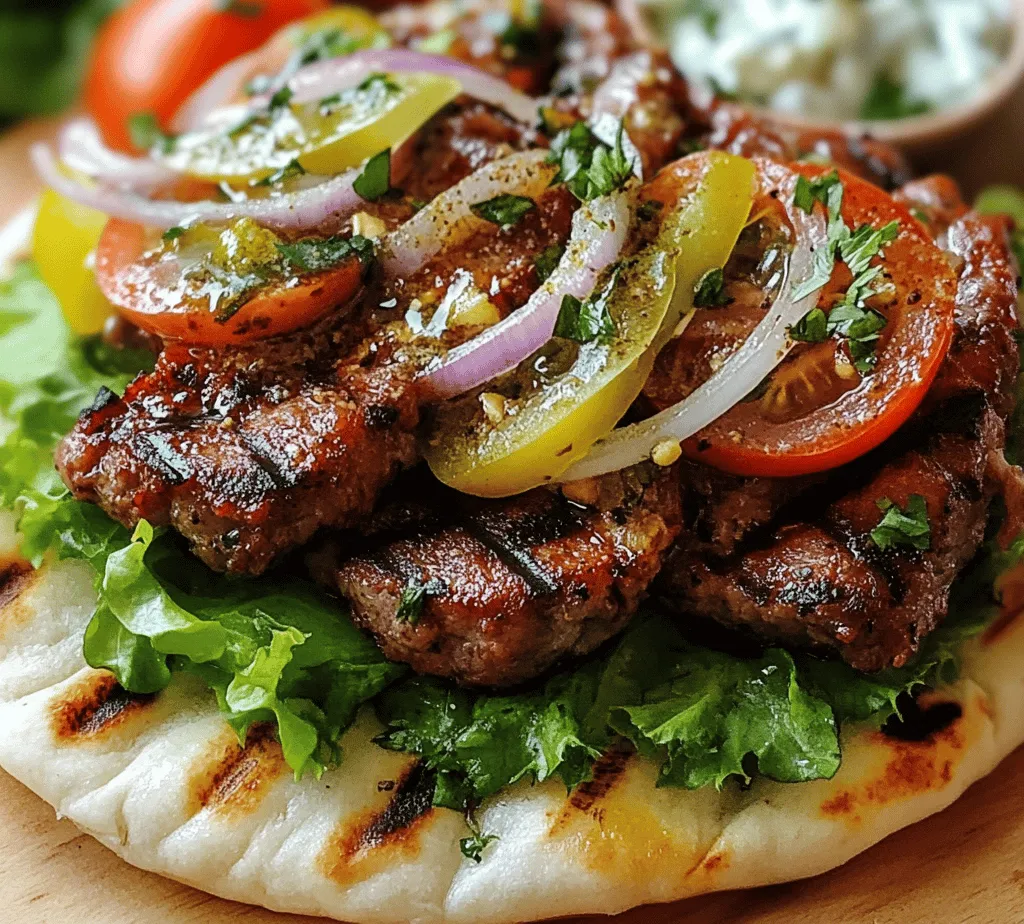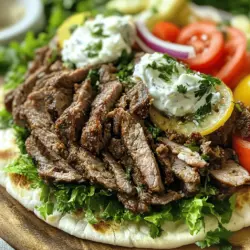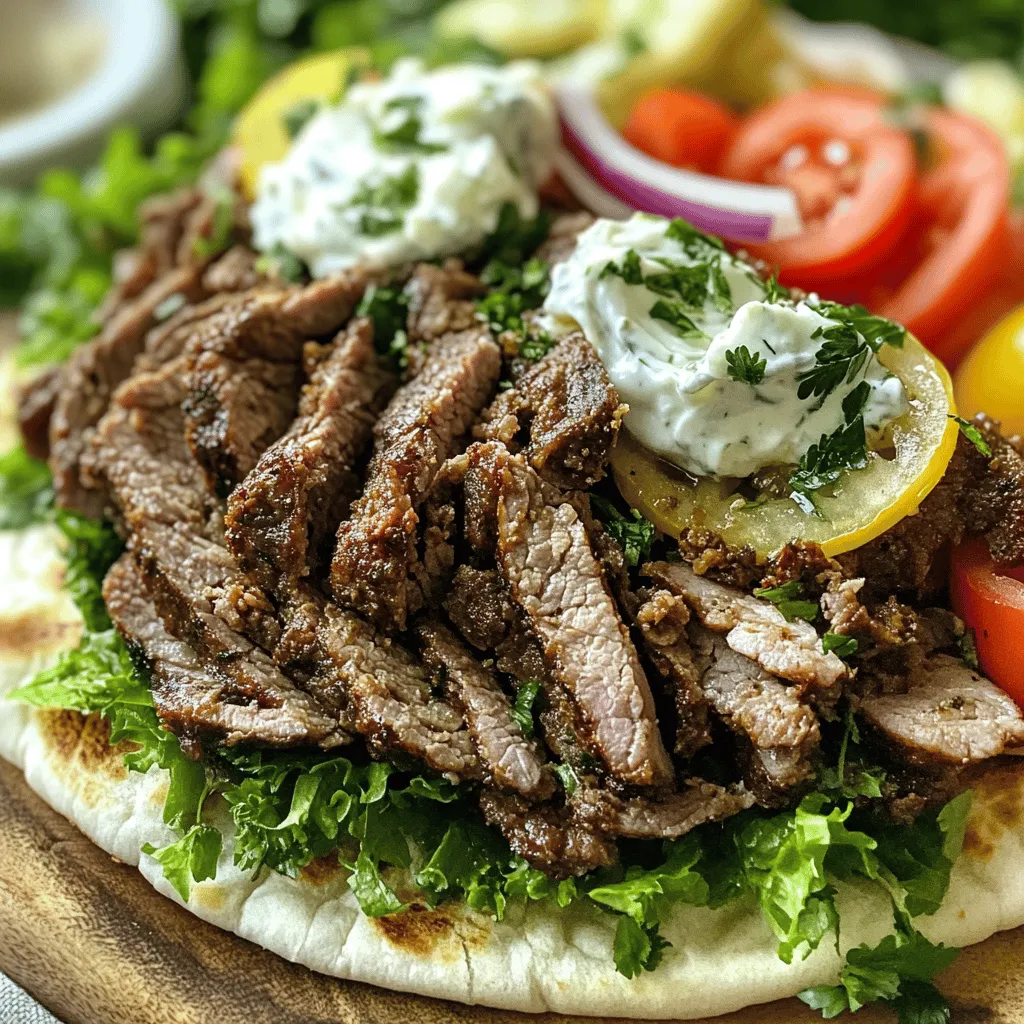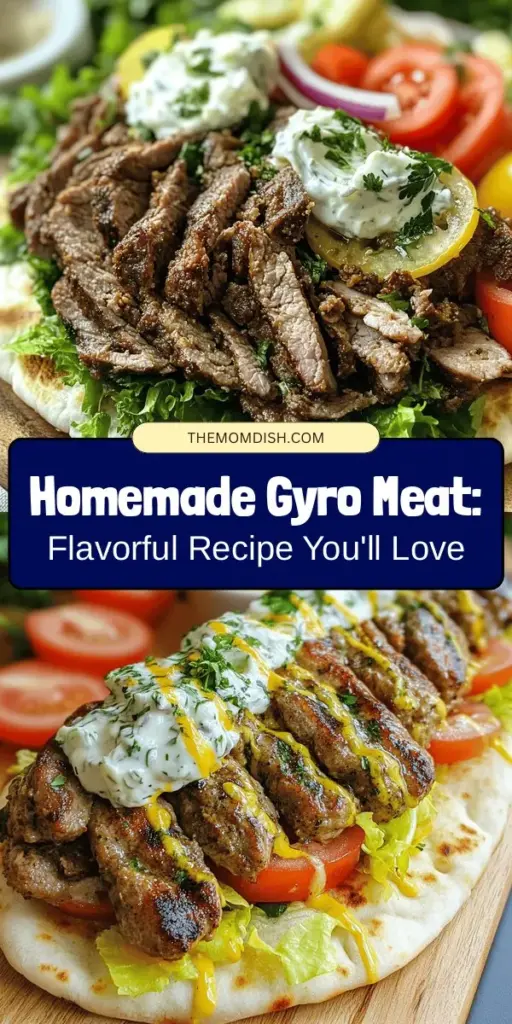Introduction
Gyros are a beloved staple of Mediterranean cuisine, celebrated for their rich flavors and satisfying textures. Originating from Greece, gyros have become a global sensation, often served in pita bread with an array of colorful toppings and flavorful sauces. The heart of this dish lies in the gyro meat, which can be made from various types of meat, including lamb, beef, or a combination of both. This versatility not only caters to different palates but also allows for a myriad of flavor profiles, making gyros the perfect choice for any meal, whether it’s lunch, dinner, or a late-night snack.
In this guide, we will walk you through a homemade gyro meat recipe that promises to deliver a punch of flavor in every bite. While there are many options for store-bought gyro meat, nothing compares to the freshness and authenticity of making it at home. By following our detailed recipe, you can create a delicious gyro meat delight that will elevate your culinary repertoire and impress your family and friends.
Understanding Gyro Meat
Gyro meat is traditionally made by stacking seasoned meat on a vertical rotisserie, allowing it to cook evenly while the outer layer is shaved off for serving. The term “gyro” itself is derived from the Greek word “gyros,” meaning “turn” or “revolution,” which refers to the way the meat rotates on the spit. This cooking method not only enhances the flavor but also creates a delightful texture that is both crispy and juicy.
The cultural significance of gyros in Greek and Mediterranean cuisine cannot be overstated. In Greece, gyros are often enjoyed as a street food, making them accessible to people from all walks of life. They symbolize community and sharing, as they are typically eaten in a casual setting, bringing friends and family together over a delicious meal. The flavors of gyro meat are deeply rooted in Mediterranean spices and ingredients, which contribute to its unique taste profile.
When comparing homemade gyro meat to store-bought options, the difference is palpable. Store-bought gyro meat can be convenient, but it often lacks the freshness and customization that you can achieve at home. By making your own gyro meat, you have complete control over the ingredients, allowing you to adjust flavors, spices, and textures to suit your preferences. Furthermore, the satisfaction of crafting a dish from scratch is unparalleled, making it a rewarding experience for any home cook.
Ingredients Breakdown
To create a flavorful gyro meat delight, it is essential to select high-quality ingredients that will contribute to the overall taste and texture of the dish. Here’s a detailed breakdown of each ingredient used in our gyro meat recipe:
Ground Lamb (or Beef)
The primary component of gyro meat is ground lamb, though ground beef is also a popular choice. Lamb offers a rich and distinct flavor that pairs beautifully with the spices used in the recipe. If you prefer a milder taste or are unable to source lamb, feel free to use ground beef or even a blend of both. The choice of meat will significantly influence the final flavor of your gyros, so select one that appeals to your palate.
Onions and Garlic
Onions and garlic play a crucial role in flavoring gyro meat. Finely chopped onions provide moisture and a subtle sweetness, while garlic adds depth and aromatic qualities. Together, they create a savory base that enhances the overall taste of the meat. Using fresh ingredients is vital, as they contribute to a more vibrant flavor profile.
Dried Herbs and Spices
The unique flavor of gyro meat comes from a blend of dried herbs and spices.
– Oregano: A staple in Mediterranean cuisine, oregano imparts a warm, earthy flavor that complements the richness of the meat.
– Cumin: Often found in Middle Eastern dishes, cumin adds a hint of smokiness and warmth.
– Paprika: This spice contributes both color and a mild sweetness, enhancing the visual appeal of the dish.
– Black Pepper: Freshly ground black pepper adds a kick of heat and complexity.
– Salt: Essential for bringing out the flavors of all the ingredients, salt is a crucial element in any meat recipe.
– Allspice: This warm spice adds a hint of sweetness and complexity to the mix, tying all the flavors together.
Fresh Parsley
Incorporating fresh parsley into the meat mixture not only boosts the flavor but also adds a pop of color. Fresh herbs are known for their brightening qualities, and parsley contributes a fresh, slightly peppery note that balances the richness of the meat. Additionally, using fresh herbs can enhance the nutritional value of the dish.
Olive Oil and Breadcrumbs
Olive oil is key for adding moisture and richness to the gyro meat. It helps keep the meat tender while providing a luscious mouthfeel. Breadcrumbs serve as a binding agent, ensuring that the meat mixture holds together when cooked. They also aid in achieving the desired texture, making the gyro meat both juicy and easy to slice.
Egg
The addition of an egg to the meat mixture serves multiple purposes. It acts as a binder, helping to keep the meat cohesive, while also adding moisture to prevent the final product from becoming dry. The egg enriches the overall flavor and contributes to a more tender texture.
Preparation Steps Explained
With a solid understanding of the ingredients, it’s time to delve into the preparation process for making your homemade gyro meat. The following steps ensure that your gyro meat is well-seasoned, flavorful, and ready for cooking.
Mixing the Meat Mixture: Techniques for Effective Blending
1. Preparation of Ingredients: Start by gathering all your ingredients and prepping them. Finely chop the onions and garlic, and measure out the dried herbs and spices. This ensures a smooth and efficient mixing process.
2. Combining the Meat: In a large mixing bowl, combine the ground lamb (or beef) with the chopped onions and garlic. Use your hands or a sturdy spatula to break up any clumps in the meat, allowing for even distribution of flavors.
3. Incorporating the Seasonings: Add the dried herbs, spices, fresh parsley, olive oil, breadcrumbs, and egg to the meat mixture. It’s important to incorporate these ingredients thoroughly to ensure each bite is packed with flavor.
4. Mixing Technique: Use your hands to gently mix the meat mixture, being careful not to overwork it. Overmixing can lead to a tough texture, so blend until just combined. A good technique is to fold the ingredients together, allowing for even mixing without excessive handling.
5. Chilling: Once the mixture is well combined, cover it and place it in the refrigerator for at least 30 minutes. Chilling the mixture allows the flavors to meld and makes it easier to shape the meat before cooking.
By following these preparation steps, you lay the foundation for a delicious homemade gyro meat delight that captures the essence of traditional Mediterranean flavors. In the next section, we will explore the cooking methods and finishing touches that will elevate your gyro experience even further.

Importance of Chilling the Meat
Chilling the meat before cooking is a crucial step in preparing flavorful gyro meat. This process significantly affects both the texture and flavor of the final dish. When meat is mixed with spices and other ingredients, chilling allows the flavors to meld together, resulting in a more cohesive and robust taste. Additionally, cooling the meat mixture helps to firm it up, making it easier to shape into loaves or patties.
The chilling process also promotes better binding of the ingredients. When the meat is cold, the fat remains solid, preventing it from rendering too quickly during cooking. This ensures that the gyro meat retains its juiciness and develops a pleasing texture. A well-chilled mixture will also help create a crust when cooked, adding a delightful contrast to the tender interior. Therefore, allowing the meat to chill for at least 30 minutes before shaping and cooking is essential to achieving a perfect gyro.
Shaping the Meat
When it comes to shaping gyro meat, there are two primary options: forming a loaf or making patties. Each method offers its unique advantages and cooking differences.
1. Loaf: Shaping the meat into a loaf is the traditional approach for gyro meat. This method allows for even cooking and helps the meat hold its shape when sliced thinly. It is ideal for cooking on a vertical rotisserie, which is how authentic gyros are often prepared. However, if you don’t have a rotisserie, you can bake the loaf in the oven or grill it.
2. Patties: Alternatively, shaping the meat into patties is an excellent option for pan-frying or grilling. This method results in a quicker cooking time and allows for a crispy exterior while maintaining a juicy center. It is also easier to serve in sandwiches or wraps.
Regardless of the shape you choose, ensure that the meat is compact and uniform in thickness to facilitate even cooking.
Cooking Techniques
Cooking gyro meat can be done through various methods, each with its pros and cons. Understanding these techniques will help you achieve the best results.
Grilling vs. Pan-Frying
– Grilling: Grilling gyro meat on an outdoor barbecue or stovetop grill pan imparts a smoky flavor that enhances the overall taste. It allows excess fat to drip away, resulting in a slightly healthier option. However, grilling requires careful attention to prevent the meat from drying out. It is essential to avoid overcooking, which can lead to a tough texture.
– Pan-Frying: Pan-frying offers greater control over the cooking temperature and is often more convenient, especially for smaller portions. This method allows for a rich, caramelized crust that adds depth to the flavor. However, it can lead to a greasier result, as the meat retains more of its fat content.
Regardless of the cooking method, achieving the right internal temperature is crucial. The USDA recommends an internal temperature of 160°F (70°C) for ground meats to ensure safety.
Tips for Checking Doneness
To check the doneness of gyro meat without compromising its juiciness, consider using a meat thermometer. Insert it into the thickest part of the meat to get an accurate reading. Alternatively, you can cut into the meat to check for any pinkness; the juices should run clear when the meat is thoroughly cooked. Be cautious, as cutting the meat can release juices, leading to a drier texture.
Serving Suggestions
Gyro meat is incredibly versatile and pairs well with various accompaniments. Here are some ideal serving suggestions:
Classic Toppings
The traditional toppings for gyro meat include:
– Lettuce: Fresh, crisp greens add a refreshing crunch.
– Tomatoes: Juicy slices provide a burst of sweetness.
– Onions: Thinly sliced red or white onions contribute a sharp flavor.
These toppings can be served in a pita or as part of a grain bowl, enhancing the overall experience of the dish.
Homemade Tzatziki Sauce
No gyro is complete without a generous drizzle of tzatziki sauce. This creamy condiment is made from strained yogurt, cucumber, garlic, olive oil, lemon juice, and fresh dill. Here is a simple recipe to prepare tzatziki sauce:
Ingredients:
– 1 cup Greek yogurt
– 1 cucumber, finely grated and squeezed to remove excess moisture
– 2 cloves garlic, minced
– 1 tablespoon olive oil
– 1 tablespoon lemon juice
– 1 tablespoon fresh dill, chopped (or 1 teaspoon dried dill)
– Salt and pepper to taste
Instructions:
1. In a bowl, combine the Greek yogurt, grated cucumber, minced garlic, olive oil, lemon juice, and dill.
2. Mix until all ingredients are well incorporated.
3. Season with salt and pepper to taste.
4. Refrigerate for at least 30 minutes to allow the flavors to meld.
The tzatziki sauce adds a tangy and refreshing element that perfectly complements the rich flavors of the gyro meat.
Alternative Serving Ideas
Aside from the classic gyro wrap, consider these alternative serving ideas:
– Salads: Serve the gyro meat over a bed of mixed greens, topped with your favorite vegetables and a drizzle of tzatziki or vinaigrette.
– Wraps: Use lettuce leaves or whole-grain wraps for a low-carb option that still delivers on flavor.
– Grain Bowls: Pair gyro meat with quinoa, brown rice, or couscous, and top with roasted vegetables for a satisfying meal.
Nutritional Information
Understanding the nutritional value of your homemade gyro meat is essential for making informed dietary choices. Here’s a breakdown of what to expect:
– Protein: Gyro meat is an excellent source of protein, which is crucial for muscle repair and overall health.
– Fat: Depending on the type of meat used, gyro meat can be relatively high in fat. Using lean cuts can help manage fat intake.
– Calories: A typical serving of gyro meat (approximately 100 grams) contains around 250-350 calories. Portion control is key to keeping meals balanced.
Using fresh ingredients in your homemade gyro recipe enhances nutritional quality. Fresh vegetables and herbs not only improve flavor but also add vitamins and minerals, making your meal more wholesome.
Conclusion
Creating flavorful gyro meat at home is a rewarding culinary experience. By following the steps outlined, from chilling the meat and shaping it to selecting the cooking method, you can achieve a delicious result that rivals any restaurant’s offering. The satisfaction of preparing this iconic dish in your kitchen, along with the versatility of serving suggestions, makes it suitable for various occasions, whether a casual family dinner or a festive gathering.
Exploring the cultural experience of preparing and enjoying gyros can deepen your appreciation for this beloved dish. So gather your ingredients, invite friends or family, and embark on a culinary journey that celebrates the rich flavors of Greek cuisine. Enjoy your homemade gyros!



